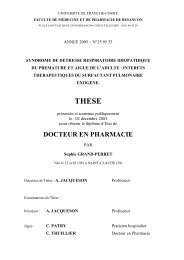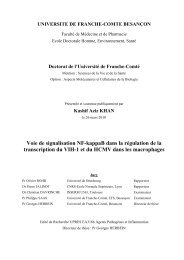THÈSE - Université de Franche-Comté
THÈSE - Université de Franche-Comté
THÈSE - Université de Franche-Comté
You also want an ePaper? Increase the reach of your titles
YUMPU automatically turns print PDFs into web optimized ePapers that Google loves.
elationship between the vegetation dynamics and the outbreak intensity (activity rate) of vole<br />
populations, Kopp (1993) showed that outbreaks lead to higher population <strong>de</strong>nsities in<br />
agricultural parcels offering better plant cover. These studies suggested that farming practices<br />
influenced the water vole populations, via habitat modifications. However, to our knowledge,<br />
no quantitative studies have <strong>de</strong>termined the effects of farming practices on the water vole<br />
populations on a parcel scale. Delattre et al. (submitted) showed that, for the same area, there<br />
can be as many as 16 to 38 times more new vole colonies within the mole networks than<br />
outsi<strong>de</strong> them. Thus, on a parcel scale, mole gallery networks may play an important role in the<br />
growth of vole colonies in the early stages of vole population increase. This phenomenon<br />
could be related to the use of available T. europaea gallery networks by A. terrestris (Meylan<br />
& Höhn 1991) and could explain the faster colonisation by A. terrestris populations un<strong>de</strong>r<br />
such conditions. This observation, to date, has never been taken into account in other studies.<br />
The aim of this study was to test the hypothesis of an impact of farming practices upon the<br />
population dynamics of the water vole on a parcel scale. We examined the effect of farming<br />
practices on the water vole populations during two parts of an A. terrestris population cycle:<br />
the low <strong>de</strong>nsity phase and the increase phase and the high <strong>de</strong>nsity phase. A wi<strong>de</strong> spectrum of<br />
farming practices are generally consi<strong>de</strong>red to be important for small mammal population<br />
dynamics (Jacob & Hempel 2003). In this study, we focused on fertilisation, mowing and<br />
disturbances caused by soil work (ploughing, stamping by cattle, etc…). We specifically<br />
analysed the impact of grazing and soil work on the water vole relative abundance at the high<br />
<strong>de</strong>nsity phase of a cyclic outbreak and, took into account mole population abundance. Our<br />
results are discussed in relation to grassland management practices in temperate ecosystems<br />
and their implications for the prevention of ro<strong>de</strong>nt outbreaks.<br />
Material and methods<br />
STUDY SITES<br />
Grassland parcels were selected in 21 communes of the Doubs and the Jura <strong>de</strong>partments<br />
(French administrative divisions - 47.11°N, 6.24°E) (Fig. 1). In these <strong>de</strong>partments, the<br />
Fédération Régionale <strong>de</strong> Défense contre les Organismes Nuisibles (FREDON, a farmers’<br />
Thèse C. Morilhat 2005 101









